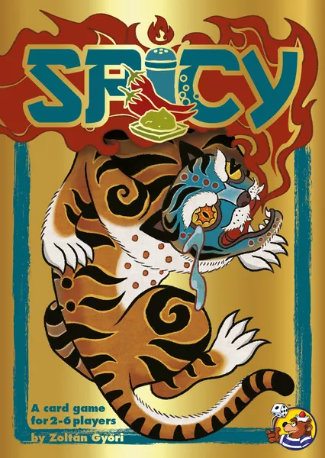Spicy Board Game Review

By MARK WILSON

Year Published: 2020
Players: 2-6
Playing Time: 15-20 Minutes
Board games carry stories, and not just in the narratives they weave mechanically but in the human context in which they reside.
One of the most poignant stories I tell about a board game involves Spicy. Spicy is a silly game, but we first have to get a bit serious.
I’m online pals with a man I’ll call Pete (not his real name), who lived in Ukraine when Russia invaded the country. Eventually Pete’s city came under attack as well, and then it was under Russian occupation.
We happened to be in some asynchronous games on Board Game Arena, and the most reliable information we could get on the war was, terrifyingly, the chat feature in our game session. Email notifications that it was my turn took on new meaning, because it meant Pete was still alive, even as bombs rained down on his city. Power would go in and out since the Russians were targeting power centers, so his turns were sporadic.
We didn’t mind, of course. The game wasn’t the point. But he wanted to keep playing, citing the sense of normalcy that board gaming gave him.
In a profound statement on the potential power of games…think about that for a second. Your home is being bombed and you’re still willing to take a turn in a game of Coloretto, or something similarly low-stakes.
To me it’s mind blowing, but it makes a certain amount of sense. Games are escapism for many of us, and this particular example takes that idea to a whole new level.
Pete eventually fled to safety with his fiance, managing to both leave the country and find employment elsewhere. This particular story has a somewhat happy ending in that sense, even though the horror of being displaced from one’s home remains. As I pen this review, the Russia/Ukraine war is still raging.
So where does Spicy enter this tale? Well, Pete had to leave behind his modest game collection when he left Ukraine, keeping only a few small-box games to play on the road. Spicy was one of them, and Pete kept bringing it up in online conversations about games he adored.
Eventually, I had to try it. What was this game that made the trip from Ukraine to central Europe that he seemed to mention any chance he got?
So I bought myself a copy, and I think about my friend every time I play.
Spicy Summary
Three eternal cats devised a hot spice food eating contest after eons of bickering in order to see who the top cat is. Their bluffing competition is destined to continue until the world itself ends.
Or something. I enjoy reading the rulebook’s premise out loud before I teach Spicy, simply because it’s quite ridiculous. This is a card game of lying to your friends; nothing more, nothing less.
Three suits numbered 1-10 and some other cards that are a wild suit (but no number) or wild number (but no suit) make up the deck. You play cards into a pile in a given suit, and with a few additional restrictions, until someone calls you on your claim. But they have to call BS on either suit or number, not both, meaning that it’s a bit of a guessing game. But the moments at which bluffs happen can inform the likelihood of number/suit being the more likely bluff.
And of course, you can use that knowledge to invert the bluff at those key moments. And thus the game unlocks.
As you win bluffs, you collect cards into a score pile. As you lose bluffs, you collect them into your hand, which are negative points at the end. If you shed your whole hand successfully, which is harder than it seems since that last card is tough to get by without a risky bluff, you’ll get a 10-point bonus before drawing a new hand.
Plus or minus a few rules, that’s the whole game.
Eternal, Lovely Cats…And Confusing Suits
I’d be remiss in not mentioning the gorgeous card art, which even extends to the cards’ borders and backs. For a small-box game, it feels luxurious.
The irony is that a lot of the game is spent staring at a face-down pile of these cards, so you won’t always be appreciating the art as you play. But it’s a game where I’m happy I own the physical copy, even though it could likely be proxied with generic components somewhat easily.
One other small note, this one less glowing: There are suits for Pepper (as in, peppercorn) and Chili (as in, chili pepper). But it’s very easy to accidentally call either one “pepper.” This has caused one too many moments of confusion for me to leave it out of this review. I hope any future editions change one or the other to a different suit. It’s a problem. The third suit, Wasabi, can stay though.
Lastly, the game’s been re-released with cutesy kitten artwork, because that’s the trend of a lot of publishers these days: put cute animals on it to try to boost sales. I can’t fault them for trying to find a new audience, but I have to mention that the artwork in this newer version is a lot worse, to my eye. The original’s artwork is so unique and bizarre; I adore it. More generic cartoon kittens just feel lesser in comparison.
Out-Bluffing Itself
I’m not going to overly sentimentalize the story of my friend above to paint a more glowing picture of Spicy than I might otherwise. I really enjoy it, and continue to own it, but there are a couple small flaws. Cockroach Poker remains my favorite pure bluffing game, and other well-regarded, simple bluffers like Skull and Liar’s Dice (aka Perudo) are just as good.
But Spicy’s a lot of silly fun, and it’s actually quicker than most or all of the others I just listed, which is no small feat since none of them are terribly lengthy. But it packs a similar punch in a game that – if everyone playing knows the game – can be played and packed up in 15 minutes.
Brevity isn’t quality, but it counts for something when it doesn’t sacrifice the experience for the sake of reducing the length.
The joy of the game isn’t so much in calling out bluffs – which can come from any player at any time – but in making them. Because, for example, sneaking a 5 of Chili into a stack where you’re claiming it is neither a 5 nor a Chili is devious fun.
So, too, is saving your 10s and wilds for those moments that, all else being equal, should be bluffs more often, but in a group’s specific meta may be just as likely to be truths.
Then there’s the final card in someone’s hand, and no one wants them to get a 10-point bonus, but you also can’t let them get away with it without claiming a bluff. And so the table plays a silent game of Chicken on who has to be the one to call. Watching this as the player who’s about to be called is delicious, especially if you have an entirely truthful card that will get you both the 10 points AND give an opponent some negative points.
When this happens, just try to stop yourself from smiling smugly. You won’t be able to.
Gamified Bluffing – Problems and Strengths
Things aren’t perfect. The fact that you’re calling out either suit or number means that you can make a correct bluff assessment, but guess the wrong element to call out.
Sometimes there are reasons to favor calling out either suit or number, but a lot of times it’s just a coin flip. This makes that moment occasionally less satisfying.
The fact that bluffs can be called by anyone at any point also means that a particularly trigger-happy player might accidentally take over a session. I had one game where this happened, causing other players to speed up their calls to match him. By the game’s latter half, we couldn’t even get to a 2-stacked pile of cards before a bluff was called. It was a strange session. Frenetic, sure, but lacking some of the delightful tension that comes with prolonged silence in such games.
Some of these issues go away when you reframe the game as something that’s merely intended to be light fun. Gamers’ occasionally dogged focus on strategy and fairness in games sometimes causes us to think less of games that are only supposed to make us laugh. But if you’re looking for strategy or even logic in your games, you’re not going to find a ton of it here.
So I can’t deny the presence of these potential faults, but I also don’t consider them too damaging. Smile and laugh and curse and shake your head or fist for 20 minutes or so, consider this time well spent, then move on, and you can have a lot of fun here regardless of the underlying strategy of it all.
Spicy – Conclusions
Is it fair to think that perhaps I have some bias due to my personal connection to this game? Probably. I do think I’m pretty good at separating my hopes and expectations from the reality that games deliver, but I was predisposed to enjoy this one, because I really wanted to.
That said, no one in my various gaming groups had that bias, and it’s been a requested game that always seems to bring smiles to those playing. I think it’s been a dud exactly once, well into double digit sessions with a variety of gamers. So the evidence seems to corroborate my experience, for which I’m thankful.
It’s also competing for attention with games like Cockroach Poker, Perudo and Skull, and others still that hang more complicated gamified structures atop the central bluffing, like Sheriff of Nottingham.
Spicy may not be “better” than these by any specific metric, but it stands alongside them just fine and may be the right blend of silly and tense for you and your group.
…
Like my content and want more? Check out my other reviews and game musings!
Read More From Bumbling Through Dungeons
Recent Posts
Categories
- All (350)
- Announcements (4)
- Board Games (203)
- DMing (28)
- Game Design (16)
- Playing TTRPGs (22)
- Reviews (189)
- RPGs (142)
- Session Reports (91)
- Why Games Matter (9)